Operational, Personnel Issues Vex a Changing Force
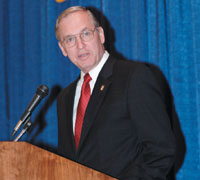 |
| Vice Adm. Arthur K. Cebrowski, USN (Ret.), outgoing director of the Office of Force Transformation, gives the Kickoff Address at West 2005. |
The U.S. military must ramp up force transformation without missing a beat in its campaign to win the war on terror, and succeeding in those two endeavors will require close coordination across many disciplines. A variety of issues ranging from advanced system acquisition to personnel training and education must be addressed in the midst of operational activities at home and abroad.
Many of these points were discussed at West 2005, the annual conference and exposition sponsored by AFCEA International and the U.S. Naval Institute. Held February 1-3 in San Diego, the three days of speakers, panels and courses focused on the conference theme, “Beyond Iraq: How Do We Get Transformation Right?”
That theme proved to be something of a metaphor for the ideas that were exchanged on the first day. The event’s first speaker was Vice Adm. Arthur K. Cebrowski, USN (Ret.), the outgoing director of the Office of Force Transformation. One day after resigning his position, Adm. Cebrowski launched into an assessment of the ongoing force transformation and threw down the gauntlet, declaring that it is time for radical changes in the way the U.S. Defense Department shapes the military.
“There is no going back—transformation is here to stay,” he said. “Who wants to be less networked? Who wants to know less? Who wants to be slow and lethargic? Who wants to be ponderous and clumsy?”
However, to address the challenges of transformation, Adm. Cebrowski called for attendees to look at transformation through the lens of economics. Defense planners are still using old business models for planning, and the admiral called for “a whole new intellectualization” for transformation and force structure.
This new approach would scrap longtime—and even recently implemented—methodologies for designing and procuring systems. Using the U.S. Navy as a model, the admiral called for changes that would permit the development of a scalable fleet. This would not take long, he offered, and a key would be the ability to create and preserve options. Instead of building one new lead ship and then conducting an analysis of it, the force would be better served if three different contracting teams build three different ships that would be compared. This would avoid the trap of “data-free research” and would give the military the ability to create and preserve options, which is key to this new methodology.
The enemy is not waiting. It has moved off the traditional battlefield, he noted, and has decided not to bear the cost of confronting the U.S. military. Instead, it is moving into political and social domains to pass the cost to the United States. These social and political domains represent a new business model to which the United States must adjust. “The force must focus on winning the war and the peace, not just on waging combat,” Adm. Cebrowski declared.
Following Adm. Cebrowski’s address was the day’s first panel discussion, which focused on lessons learned in the Iraq War. Some of the panelists wasted no time in citing Adm. Cebrowski’s points—and in disagreeing with most of them.
Ralph Peters, author of Beyond Baghdad: Postmodern War and Peace, charged that Adm. Cebrowski’s transformation approach largely is irrelevant in the war on terrorism. The terrorists’ network-centric warfare works because they employ it smartly, he said. Technology does not win wars by itself, and linear models of force strength do not work. Peters called for greater focus on the human aspects of defeating an enemy, including understanding cultural issues and having better human intelligence.
Panel moderator Maj. Gen. Robert Scales, USA (Ret.), co-author of The Iraq War, said that the transformation is more than 10 years old, and it is time to hold it up and look at it. An observer can see the threads of continuity running from the present to the future, and the challenge is “to reach into the chaff and pull out the wheat,” he stated. Today’s transformation is based on network-centric warfare, but that works better over the larger scale. In this war, the success of networks is on the local level in settings such as back-alley payoffs.
The day’s most noted comments came from Lt. Gen. James N. Mattis, USMC, commanding general, U.S. Marine Corps Combat Development Command. Gen. Mattis began by agreeing with Gen. Scales that the United States’ very dominance of modern forms of warfighting has driven the enemy into primitive forms of fighting for which this country has not prepared. “Don’t patronize this enemy—they mean business,” he warned. “They mean everything they say.”
Citing the need to diminish the conditions that provide recruits for the enemy, the general also was warfighter-blunt about the need to kill all of its forces. “You go into Afghanistan where guys slapped women around for five years simply for not wearing a veil—they have no manhood left. It’s fun to kill them.” Some of those remarks by Gen. Mattis were picked up by major media outlets and transmitted worldwide.
Christine Fox, president of the Center for Naval Analyses, a nonprofit research organization, compared processes in the 1990s with today’s environment. In the 1990s, the doctrine largely comprised an unwillingness to take risks and an unwillingness to risk civilian casualties. She called for force planners to engage a degree of risk, and a key to making that work is for tactics, doctrine and procurement to be decided at the tactical level.
Cmdre. Peter Jones, RA N, former commander of the interdiction force in the Iraq War, related how interoperability in the littoral environment involved maritime and land forces from several nations and different services. While network-centric tools were a big help, there is a need for officials to clearly articulate their philosophy of command.
Adm. James Hull, USCG (Ret.), former commander, Atlantic Area, noted that a new maritime force for the United States comprises the Navy, the Marine Corps and the U.S. Coast Guard. This force took part in operations in Iraqi waters, and participants learned much from their interoperation. One key lesson was the importance of small patrol boats, which the Navy is moving away from, and boarding teams for protecting key maritime and coastal assets.
 |
| Adm. Vern Clark, USN, chief of naval operations, gives the Keynote Luncheon Address at West 2005. |
The admiral seemed to strike a balance between Adm. Cebrowski’s position and the contrary statements of the panel that followed. Adm. Clark acknowledged that the current U.S. military was created to fight a traditional enemy and the current adversary is anything but traditional. However, while change is necessary, the military must retain that traditional capability.
Yet, the current fighting in Iraq probably is the most likely harbinger of future military operations. The military must design a force from the ground up that will optimize itself for this new challenge. “We can talk about transformation, but until we know our tasks and missions and types of conflicts, we won’t be able to determine what we need [so that we will] know what we really will build for,” he said.
After the year 2006, all new ships and boats will be never-before-seen designs, he noted. Change is at hand. The characteristics that will allow the Navy to respond to its challenges will involve lethality, especially speed and agility, in packages different from those of today. Adm. Clark offered that it was foolish to assemble large force sets that made it easy for an enemy to attack.
The admiral cited the need for a strong partnership between the military and industry as absolutely essential for building an effective future force. Large areas of the military will look at post-Iraq investments, he said, and now is the time for discussion.
The first day’s afternoon panel focused on how best to experiment in a joint environment. Panel moderator Capt. George Galdorisi, USN (Ret.), director of the Decision Support Group at the Space and Naval Warfare Systems Command (SPAWAR) Systems Center, noted that each service has its own experimentation culture that has evolved over the decades.
Col. Vincent J. Goulding Jr., USMC (Ret.), director, Sea Viking, Marine Corps Warfighting Laboratory, emphasized that today a disproportionate effort goes into focusing technologies to centralize decision making. Instead, he says, the Marine Corps wants to disperse decision making down the chain of command. Distributed operations is the concept, and this will be a tough project over the next 18 months. Goulding added that joint sea basing underpins all Marine Corps experimentation.
Dr. Tom Hone, assistant director for risk management at the Office of Force Transformation, said that information and insights must be gathered and shared for experimentation to work. While this approach encourages competition, it may be too difficult to do experimentation across the board. Also, combatant commands focus on advanced concept technology demonstrations (ACTDs), but these tend to be near-term experiments. The path to transformation may not lie through ACTDs, he said. His office hopes to draw an experimentation map for the secretary of defense in the near future.
Vice Adm. Michael J. McCabe, USN, commander of the Third Fleet, described how the fleet has embedded exercises in experimentation, adding that experimentation is just a routine part of the fleet’s day-to-day existence. This approach has enabled it to push new capabilities out more rapidly in coalitions, and it has worked well, he said. However, experimentation must take place in earlier stages, as some items are moving slowly into the fielding stage.
Maj. Gen. John R. Wood, USA, director for joint experimentation, U.S. Joint Forces Command, offered that joint concept development experimentation is good. However, the military does not do an enormous amount of collaboration in joint experimentation, and it can do better. He suggested that the combined joint task force would be an appropriate integration place for joint experimentation—not for everything, but for what it takes to fight effectively. “Let’s organize the way we fight,” he concluded.
The second and busiest day of West 2005 featured a full day of speeches and panels. While the discussions may not have been as contentious as those of the first day, many of the topics aired by speakers and panelists touched on common themes.
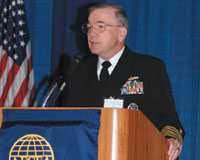 |
| U.S. Pacific Fleet Commander Adm. Walter F. Doran, USN, gives Wednesday’s Breakfast Address at West 2005. |
The fleet has changed its behavior pattern to increase its visibility in the western Pacific Ocean, the admiral related. This new deployment pattern is accompanied by a focus on the most difficult theater warfighting categories.
One area where the Pacific Fleet has increased its emphasis is on antisubmarine warfare. The fleet has trained with new sensors such as an automated rapid periscope detection system and low frequency active sonar. An undersea warfare decision support system has great potential, the admiral offers, adding that the fleet can integrate its antisubmarine warfare assets better.
The fleet also participated in relief efforts following the post-Christmas tsunami in Indonesia. Adm. Doran stated that the size and speed of the fleet’s relief effort represent a persuasive display of U.S. Navy capability.
The admiral in charge of the largest area of responsibility for any one fleet discussed the need for maritime domain awareness. Saying, “Maritime situational awareness is an idea whose time has come,” Adm. Doran stated that maritime interdiction is an area with great growth potential. The development and fielding of maritime domain awareness tools is essential, he declared.
The subject of networking the fleet came up in one of the day’s morning panels. This group focused on how the Navy’s FORCEnet will deliver its promises and how the Navy can keep U.S. allies plugged in.
Rear Adm. Kenneth D. Slaght, USN, commander, SPAWAR, related how the Navy’s IT-21 program took the first “baby steps” to FORCEnet. However, IT-21 has problems such as bandwidth constraints and little redundancy. And, if one were to break down FORCEnet, that person would find that every individual component is stovepiped. Adm. Slaght listed three key FORCEnet issues: achieving architectural compliance, aligning with mission capabilities and ensuring governance.
Col. James J. Kuzmick, USMCR (Ret.), told the audience that FORCEnet must enable the network-centric warfighter to turn data into knowledge. However, interoperability is not free, and he characterized it as an “unfunded federal mandate.” Joint interoperability should be funded separately and independently through programs of record, he said.
The British perspective on FORCEnet was provided by Cmdre. Peter Walpole, RN, deputy, U.K. Striking Fleet Atlantic. Cmdre. Walpole noted that the U.S. Defense Department’s second priority—after the global war on terrorism—is to strengthen combined joint warfighting. He described it as good news that the U.S. Navy is the executive agent for the multinational information-sharing initiative. Technologically speaking, good progress has been made. The commodore also cited the role of NATO in ensuring interoperability.
Cmdr. Gregory Glaros, USN, of the Office of Force Transformation, declared that FORCEnet is not just about technology—it’s about relationships. A key to its success will be to bring in all of the autonomous and semi-autonomous agencies involved in FORCEnet.
A concurrent panel focused on the questions, “Defense Acquisition: What Works? What is Broken?” Acquisition is leadership and management, explained Rear Adm. Dave Oliver, USN (Ret.), executive vice president and chief operation officer of EADS North America, the panel moderator. He questioned whether the Navy is set up to do the best job both now and in 30 years. According to Adm. Oliver, not enough attention is being paid to the personnel aspects of the acquisition discipline for the long term. “You wouldn’t assign a nonpilot to head naval aviation,” he proclaimed, contrasting that to what is done in the acquisition discipline.
The good news is that the acquisition process overshadows the challenges, according to panelist Rear Adm. William Cobb, USN (Ret.), representing Anteon Corporation. Adm. Cobb explained that what works in today’s acquisitions includes having smart and dedicated leaders, having the best equipment in the world and having good training.
Challenges, the admiral acknowledged, include the need to change the financial system within the Defense Department because it is too cumbersome and not agile enough; the need to add incentives, giving a portion of any program savings back to the managers to use; the need to put more acquisition people in the Pentagon; and the need to eliminate some of the hands in the pie.
“What is good is manifested in the number of successful programs,” said Dr. Philip A. Dur, president of Northrop Grumman Ship Systems, echoing some of Adm. Cobb’s comments. Dur acknowledged that the traditional line of criticism is in the cost overruns and delays. He listed some of the root causes for the schedule delays as a lack of technical maturity, requirements that are out of line with resources as well as funding challenges, including unrealistic budgets and estimates.
Technical maturity can be addressed by having independent panels provide technology reviews. Systems engineering can be employed to look at resources before requirements are formalized. Dur also advocated using a process that determines a rough order of magnitude of the estimates early on. He said he prefers range pricing versus single point pricing.
Central to much of what Dur was recommending was better control of requirements, including early involvement with industry to determine realistic requirements. New requirements should not be allowed without funding them accordingly. Dur suggested a management financial reserve, with its use restricted to avoid requirement creep.
Pat Finneran, vice president and general manager, aerospace support, The Boeing Company, also emphasized the importance of industry participation in requirements definitions. “I’m a win-win guy,” he said, explaining that his favorite contract is fixed-price incentive because it is a win-win for government and industry. He recommended integrated versus segmented solutions.
John J. Young Jr., assistant secretary of the Navy for research, development and acquisition, identified some things he believes are nearly broken. These items include the two-year process to develop valid requirements, the short time that people tend to serve in the requirements community and the control of requirements. He agrees with Adm. Cobb that the involvement of too many hands, particularly in a broken process, hinders success.
“But, at the end of the day, the success is measured in how effectively we spend taxpayer money to support the sailors and Marines,” Young concluded.
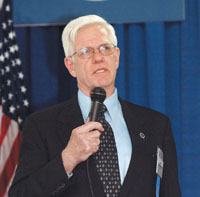 |
| Dr. Linton Wells II, acting assistant secretary of defense for networks and information integration and U.S. Defense Department chief information officer, gives Wednesday’s Luncheon Address. |
Wells listed five key network-centric programs: the Global Information Grid (GIG)-Bandwidth Expansion (BE), the Joint Tactical Radio System (JTRS), transformational communications satellites, network-centric enterprise services and GIG information assurance. The GIG-BE program is on schedule to meet its next milestone by September, and transformational communications satellites will receive significantly higher funding in 2006. However, Wells said that he is disappointed in JTRS Cluster 1 and may restructure it. The other JTRS clusters are not a problem.
He elaborated that information assurance underpins all of these efforts. The National Security Agency has delivered six different plans that shy away from traditional digital “moats” in favor of strong identification authentication.
Wells said that he was encouraged by the 2006 budget process with information technology programs receiving strong support from Defense Department members. But, the single biggest issue that Wells raised is the department’s drive toward a data strategy.
This data strategy (SIGNAL, January 2005, page 37) will enable smoother exchange of information throughout all aspects of the network by standardizing data. It would serve both authorized and unanticipated users such as coalition partners. Wells also predicted an increased emphasis on “sense-making.” The goal is to make sense of data for the user.
The Navy’s human-capital strategy was the discussion topic for the second day’s afternoon panel. Panel moderator Vice Adm. Albert H. Konetzni Jr., USN (Ret.), former deputy commander and chief of staff, U.S. Fleet Forces Command, charged that there is no Navy human capital strategy. While the Navy is committed that people are its most important resource, a good strategy can help young sailors improve personally and professionally every day.
The master chief petty officer of the Navy, MCPON Terry Scott, USN, says that the Navy’s human capital strategy is capabilities-based and deals with outcome. While it is working—which is evident in personnel performance in the war on terror—it could be better. The key is dedicated, involved leaders, he said.
The superintendent of the U.S. Naval Academy, Vice Adm. Rodney P. Rempt, USN, described how education is a foundation for human capital policy. This lifelong process must ensure that sailors are technologically savvy and can communicate effectively. To that end, Adm. Rempt suggested the Navy establish a set of requirements for personnel: an E-8 would be required to have at least an associate’s degree; an officer would need a bachelor’s; and an O-5 would need a master’s. The Navy must deliver this level of education to the entire force, he added.
Terry Halvorsen, deputy commander, Naval Personnel Development Command, offered that a human capital strategy focuses on a change-management capability, and it requires better integration of training and education activities. It is possible to concentrate on the mission while concurrently improving the sailor, he said.
In practical terms, it is all about combat readiness, offered Rear Adm. Richard K. Gallagher, USN, commander, Carrier Group Four. First, the Navy must determine what its missions will be and then design policies to put people where they need to be. The service must encourage better educated people to be career personnel, and it must ensure that its people are happy in their jobs. Change the work first, and then change the workforce, he stated.
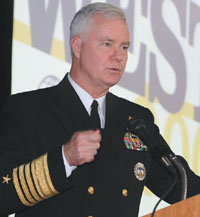 |
| Adm. Timothy J. Keating, USN, commander of the U.S. Northern Command, gives the final day’s Luncheon Address at West 2005. |
When the al Qaida terrorists struck on September 11, 2001, the United States did not have unity of command for homeland defense, the admiral said. No one thought it was necessary. The North American Aerospace Defense Command (NORAD), which he also commands, was focused externally, not internally. Now, NORAD is very focused internally as well as externally. About 75 percent of NORAD’s sorties are flown by members of the Air National Guard or the Reserve.
However, scrambling jet fighter aircraft to deal with a homeland security threat is a last resort. True homeland security can be achieved only with layered security employing various measures such as airport passenger security. And, this requires that the Northern Command work closely with other government agencies at various levels.
Adm. Keating offered that his command is redefining jointness and interoperability as it builds relationships. It is vital to establish effective relationships before disasters occur, he noted. And, intelligence and information are critical to the command’s success.
He observed that the maritime aspect of homeland defense has been neglected. The concept of a maritime NORAD is a “bumper-sticker approach” to an issue that is more restrictive than officials want it to be, he added.
“This war will test our resolve to defend and encourage freedom around the world,” he declared. “We are at war; it will be a long war; we will prevail.”
The importance of support for military personnel came as no surprise to the many active duty and retired military personnel in attendance. Achieving it, however, is another story, as the day’s Military Affairs Advisory Council Breakfast speaker explained.
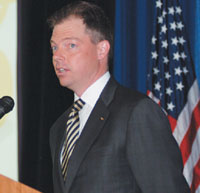 |
| Christopher Michel, founder and president of Military.com, gives the Military Affairs Advisory Council Breakfast Address at West 2005. |
Michel related how he had to pound the pavement visiting venture capitalists for three months a few years ago before he was rewarded with funding. At that, after receiving $5 million in startup money, he learned he was competing against four other military benefit Internet startups, including one funded by H. Ross Perot. His venture suffered many of the same growing pains that plagued other dot-com sites, including a series of layoffs that reduced his workforce by 80 percent with funds running out.
However, the company closed a number of business deals and reworked its business plan as it grew successful. The culmination of his efforts was the site’s acquisition by Monster late last year. This enabled service members to use the vast resources of that large firm in concert with Military.com’s benefits packages.
Along the way, Michel—himself a veteran—learned which benefits were most sought after and which ones posed the greatest difficulties for service members. Education is the leading component of the site’s activities. The site helps service personnel apply for college, and it processes 3,000 college applications each month. Enlisted personnel alone have access to $300 million in scholarship money. On the other hand, Veterans loans are way too complicated, he stated, and this poses difficulty for service men and women trying to take advantage of that benefit.
Michel pointed out that transition points in a military life often are difficult for an individual to handle alone. In the course of establishing ways to help service personnel access Defense Department benefits, site planners began to branch out into having the site provide benefits of its own. Michel noted that Monster has 300,000 employers as clients, and this has helped establish a military mentor program that involves 60,000 people. And, his site has just won a contract for service members’ spouse employment.
“You’re in a noble profession,” he told the active and former military personnel in attendance. “Take advantage of that—take advantage of the network.”
Moving offshore, a panel of experts discussed the concept of sea basing. Panel moderator Lt. Col. Frank Hoffman, USMCR (Ret.), research fellow at the Center for Emerging Threats and Opportunities (CETO), opened the discussion with a comment about the lack of mention of sea basing in the speech 48 hours earlier by the chief of naval operations. CETO is a think tank that operates as a division of the Expeditionary Force Development Center, Marine Corps Combat Development Command. Not only should the admiral have spoken about it, the colonel said, but he also should take the lead on sea basing.
Vice Adm. Charles W. Moore Jr., USN (Ret.), vice president for F-35 program assessments at Lockheed Martin and a former deputy chief of naval operations for fleet readiness and logistics, offered that the Navy has not yet come to believe in sea basing, and it will not do something unless it believes in it. Adm. Moore related how the difficulty in securing foreign air bases for operations in Afghanistan and Iraq points out the need for sea basing. More telling is that, even after being offered a package of $30 billion in aid, Turkey refused to let the U.S. Army’s 4th Infantry Division move into Iraq from the north. Give the Navy $30 billion, and it will provide a sea-basing capability that can be used over and over again, he said.
Col. Ron Isom, USA, Futures Center logistics chief, U.S. Army Training and Doctrine Command, emphasized that the United States must come up with a solution set to avoid another situation like the one it had with Turkey. If it does not, “then we are just fooling ourselves,” he said. The Army remains a heavy force and will be for many more years, and there is no U.S. Air Force heavy-lift capability that serves all of the Army’s needs. The colonel added that any sea-basing concept would rely heavily on the Navy’s Sea Shield defense system.
Maj. Gen. Harry Jenkins, USMC (Ret.), director, business development and congressional liaison, ITT Industries, offered that the core of sea basing would be whatever the maritime pre-positioned force will look like. This sea-basing force must be joint, as it will include the Army with its own pre-positioned ships.
Rear Adm. George Worthington, USN (Ret.), former commander of the Naval Special Warfare Command, discussed the presence of special operations forces in sea basing. Their presence in the littoral environment will affect warfare greatly, as all the services’ special operations forces will be involved in future sea basing. This will bring a new dimension to littoral combat.
Rear Adm. Richard O’Hanlon, USN, director, Standing Joint Force Headquarters, U.S. Joint Forces Command, raised several issues that must be determined for sea basing to be effective. Many questions remain to be answered, he said, including what kind of joint command and control a sea base should have; whether it should be a joint headquarters; whether a joint headquarters should be based there; and whether it should be a special operations force base.
A panel charged with discussing the right balance for joint interagency cooperation began with a proclamation by its moderator. “Anything we get is better than what we have,” said Adm. Leighton W. Smith Jr., USN (Ret.), former commander, U.S. Naval Forces Europe, who maintained that there is no joint interagency cooperation.
Smith led the panel in a question-and-answer format, first asking Kent Wiedemann, former U.S. ambassador to Cambodia, why interagency cooperation isn’t effective in its current form. Wiedemann responded that interagency cooperation was good during the Cold War and during the 1990s when the threats were not so existential. But, he said that after 9/11, all previously existing structures broke down and it was no longer clear who was in charge of addressing the nonstate threats.
Adm. Smith then asked Vice Adm. Harvey Johnson, USCG, commander, Pacific Area Command, if joint interagency cooperation is better or worse under the U.S. Department of Homeland Security. The admiral responded by saying it depends where you are on the continuum; 9/11 changed the balance, and the senior strategic level needs to be clear on who is leading.
In a separate question, Smith asked if the Homeland Security Department is as complicated as it looks. Adm. Johnson responded that it is important to remember that it is a brand-new department with 22 agencies and 180,000 people. “We live in a society of instant success, but no organization that large comes together so smoothly,” particularly in an election year under as many as 22 congressional committees, he added. The department is going to mature, he continued. “We are safer than we were two years ago, and former competitor organizations are now cousins.”
Vice Adm. John Morgan, USN, deputy chief of naval operations for information, plans and strategy, said he is optimistic about moving toward more cooperation. He said he sees encouraging signs, using the Joint Harbor Operation Command as a good example of how to build command centers in the future. He also pointed to the recent tsunami disaster relief in Indonesia as a demonstration of how the U.S. Navy and others can swing into action, across agencies and internationally.
Maj. Gen J. Michael Myatt, USMC (Ret.), chief executive officer, Marines’ Memorial Association, said that after Desert Storm and the cease fire, interagency cooperation was ad hoc. What happened then was not reviewed for the current operations. The general also said that, with the creation of the Northern Command, finally there is a combat command that worries about homeland actions.
Adm. Smith asked Adm. Johnson if the United States is headed toward clarification of who is in charge and who is supporting. Adm. Johnson said that he is optimistic that it is. “We have grown up since 9/11,” Adm. Johnson stated. In the ports, he explained, all major players plan and work together from top to bottom through many layers of cooperation.
The cultural, organization and competitive issues that have existed are changing. Adm. Morgan said that, if you look at the young officers, they are growing up with interdependencies such as globalization and the Internet. Access to information forces us together, he added. He emphasized that he believes all trends are in the right direction.




Comments